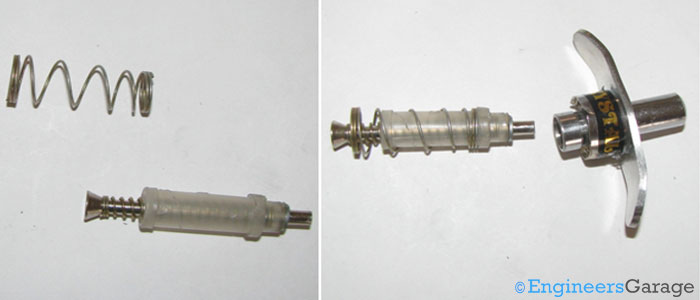It is nothing but the most commonly used home appliance “gas lighter”, used in every kitchen to generate the spark. Let us understand the technology behind the piezoelectric gas igniter or commonly known as gas lighter.

Piezoelectric gas igniter finds its application where batteries or mains electricity is not available, based on the impact of a spring-driven hammer on piezoelectric crystal giving a high voltage.
Now after learning basic definition about piezoelectric gas lighters we move on to its eternal structure and its internal parts.
As seen in the image above, the external body is made up of steel which encloses all the internal components.

The external part consists of a piston at top of the lighter. When the above piston is pushed to a certain point, it produces a spark at the ignition head with a sound.

The image above shows the bottom part of the gas lighter. This part is known as ignition head. The ignition head is in form of capsule. The ignition head contains a thin metal rod covered with the plastic casing. When the piston is pressed, we get a spark at the corner of the metal rod. Interestingly the position of the produced spark varies each time we push the piston.
After observing the external structure we move on to the internal parts. As we pull off the piston from the top we can see its internal structure as shown below.

On removing the piston arrangement we see another thin metal rod coming out from the main body of the lighter. It is connected with the piston, so when the piston is pressed it is pushed down.
Now if we pull out the metal rod out of the main steel body we will get the structure as shown below.

This is the entire internal structure inside the piston. While one end of piston is the metal rod the other end of piston is a little hammer. It has plastic covering above it with two springs – (a) the outer spring which is used to push the lever inside and to bring it back to the same position when the piston is released, and (b) the inner spring is used to push the metal rod so that the small hammer can strike the crystal for generating the spark and as soon as piston is released brings back the hammer to its same place while the plastic covering remains in a fixed position.
The below figure shows the entire opened structure

If the gas lighter is cut from the center as shown in figure we can see other internal components present in the lower part.

When the piston is triggered the spring loaded hammer strikes with the internal components of the lighter.

This is the internal lower part of the gas lighter.

Inside the steel body all internal parts are arranged according to the above image. The spring powered hammer strikes a metal knob shown in the below image.

This is the metal knob that is placed closed to piezo crystal so when the hammer strikes the knob it hits the piezo crystal to develop high voltage. The arrangement is in the figure below.

Lastly we study the internal part of ignition head. The figure is shown below.

The ignition head comprises another nail shaped rod through which the electric voltage is passed and a spark is generated at its edge.
Finally we look at the entire internal arrangement all together again.

All the major components of gas lighter are shown in the above image all internal components within the body of the lighter. All these parts works together in order to produce the spark.
The ignition rod and the piezoelectric crystal are shown clearly in the above image.

The main component which is responsible for generating spark is piezoelectric crystal.
Piezoelectric crystal is the heart of the lighter which works on piezoelectric effect.
These crystals when compressed or struck they generate an electric charge. These crystals are known as piezoelectric crystals and this effect is called piezoelectric effect. The vice versa is also true for piezoelectric crystals, i.e. If an electric current is applied on piezoelectric crystal, they change their shape slightly.
This property makes the piezoelectric crystals so desirable and that is why used in the gas lighters where a little hammer strikes with the piezoelectric crystal generating a high voltage, low ampere current. One such example of piezoelectric crystal is quartz.
Working of piezo igniter
When the piston is pressed, a spring powered hammer strikes the knob which further hits the piezo element or quartz crystal thus creating a slight deformation in the crystal. As already mentioned above, the piezo crystals on applying pressure leads to charge distribution leading to voltage difference. This sudden forceful deformation produces a high voltage and subsequent electrical discharge, which flows into the metal rod at ignition head. This voltage is high enough to generate a spark for the ignition.
So from the working mentioned it is clear piezoelectric crystal is responsible for the spark and that is why known as the heart of the lighter.
Filed Under: Insight


Questions related to this article?
👉Ask and discuss on Electro-Tech-Online.com and EDAboard.com forums.
Tell Us What You Think!!
You must be logged in to post a comment.